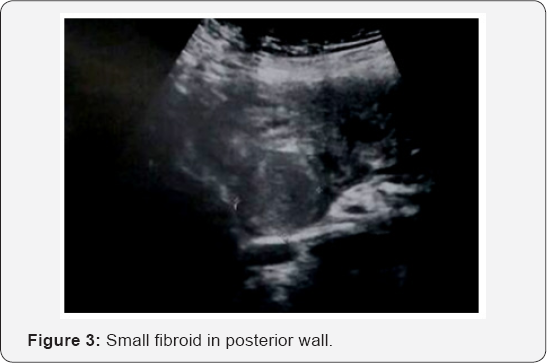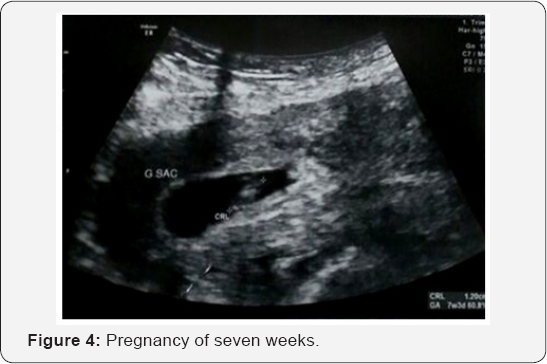Juniper Publishers- Open Access Journal of Case Studies
A Case Report of Multiple (29) Myomectomies
Authored by Kathpalia SK
Abstract
Fibroids uterus also called uterine leiomyoma are the most frequently encountered benign tumours of the uterus. Many fibroids are asymptomatic and are picked up on routine examination. Clinical features depend on number, size and location of the fibroids. Symptomatic fibroids may be managed medically or surgically. Hysterectomy by different routes is the commonest operation performed for fibroid uterus. Hysterectomy may not be the desired where uterus needs to be retained for different reasons. Removal of fibroids called myomectomy followed by reconstruction of uterus is the correct and desired mode of management in such cases. We report one such case where 29 fibroids of varying sizes were removed abdominally and uterus reconstructed in an unmarried girl who conceived spontaneously within one year of surgery after marriage. Vasopressin is effective in reducing the blood loss at the time of myomectomy. Mifepristone is a new mode of treating fibroids medically.
Keywords: Fibroid; Myomectomy; Mifepristone
Introduction
Fibroids uterus also called uterine leiomyoma are the most frequently encountered benign tumours of the uterus. Their incidence has been reported as high as 20% among women of reproductive age group [1]. Prevalence may be even higher if routine ultrasonography is performed among all women [2]. The fibroid may be single or multiple, some fibroids are small where as some may attain huge size that the woman may appear full term (Figure 1). Most of the fibroids are asymptomatic and are picked up on routine examination. Clinical features depend on number, size and location of the fibroids.

Symptomatic fibroids may be managed medically or surgically. Hysterectomy [3] by different routes is the commonest operation performed for fibroid uterus. Hysterectomy may not be the desired modality of treatment where uterus needs to be retained for future child bearing, menstrual function or for her strong willingness to retain the uterus. Removal of fibroids called myomectomy followed by reconstruction of uterus is the correct and desired mode of management in such cases. Fibroid/ fibroids may be removed by different routes like abdominally, laparoscopically or hysteroscopically.
First successful abdominal myomectomy was performed as early as 1845 but was not put into much use due to the belief that it was dangerous, difficult and associated with high mortality. This operation was highly advocated and propagated by Victor Bonney who is known as pioneer of this operation.4 Aim of myomectomy is not only the removal of fibroid/fibroids but it is also to reconstruct a functional uterus which should be able to carry pregnancy. Sometimes this reconstruction is not feasible; this usually happens in very large fibroid or multiple fibroids which leave the remaining uterus totally distorted. Hence if the uterus can't be reconstructed then that becomes a relative contraindication to myomectomy. Sometimes the surgery may result in excessive hemorrhage and the only remedy to control that hemorrhage is hysterectomy. The patients should be counselled about the possibility of hysterectomy before embarking on myomectomy. We report one such case where 29 fibroids of varying sizes were removed abdominally and uterus reconstructed.
Case Report
23 years old unmarried lady reported with complaints of lump abdomen noticed three to four months back. Onset of the lump was insidious and had been growing slowly. She had mild and constant discomfort in her lower abdomen but there was no pain as such. There were no bladder or bowel symptoms. Her menarche was at normal age and her menstrual cycles were regular and of normal flow. She had shown herself to a local doctor and basic investigations had indicated that she had multiple uterine fibroids of different sizes, the largest being 11 to 12cm. Family history revealed that her elder sister was married; had multiple fibroids and was posted for myomectomy which could not be performed and emergency hysterectomy had to be carried out. General and systemic examination was normal. Per abdomen examination showed an abdominopelvic mass which was irregular and bosselated and was of the size of 28 to 30 weeks gravid uterus. Mobility was restricted. Repeat ultrasound confirmed the diagnosis of multiple fibroids; most of them were subserosal or intramural, none appeared being submucos. All other relevant investigations were normal. She was posted for myomectomy after pre-anesthetic checkup. She was explained about the risks of surgery, possibility of ending up in emergency hysterectomy and multiple blood transfusions; and informed consent was obtained. Preoperative bowel preparation was done as the difficulties of surgery could not be predicted. Under general anesthesia the abdomen was opened by midline vertical incision which was extended above umbilicus. The incision was large enough to get adequate exposure and manipulation. Peroperative examination showed multiple fibroids occupying the whole of the body but lower segment was free from fibroids. A catheter was used pericervically in the lower segment as a tourniquet along with vascular clamps on infundibulopelvic ligaments to reduce the blood supply.
It did not appear feasible to remove so many fibroids through a single incision on the uterus. Total of five incisions were given over the most prominent part of the fibroids. Liberal infiltration of vasopressin diluted in normal saline was done before incising. One ampoule containing 20 units was diluted into 50 to 60ml normal saline and total of approximately 130ml of such fluid was used throughout the procedure. 29 fibroids (Figure 2) were removed by using cautery, blunt and sharp dissection and the remaining cavity was obliterated with multiple layers of polyglactin ensuring that the raw bed had stopped bleeding. There was some ooze from the incision sites hence one intraperitoneal drain was introduced and abdomen closed in layers. Blood loss during surgery was more than one liter hence she was transfused three pints of packed red cells. Total duration of surgery was approximately three hours. Broad spectrum antibiotics were started preoperatively and same were continued postoperatively. She developed fever the next day which subsided after three days with supportive therapy alone, postoperative Hb was maintained.



Since she was a case of multiple fibroids and strong family history, some micro and mini fibroids could have been left behind which would have grown during future course. She was put on Mifepristone; 25mg daily for ten months till she got married, during this period she developed oligomenorrhoea. There were no side effects of the medication. Repeat ultrasound done six months after surgery showed three to four small fibroids; all less than 1cm. She was advised not to delay conception. She conceived spontaneously within three months of marriage and ultrasound showed a small fibroid posteriorly (Figure 3) and intrauterine pregnancy of seven weeks (Figure 4). She underwent an elective LSCS at 37 weeks of gestation and delivered a 2.9Kg male baby, there were no visible and palpable fibroids.
Discussion
Fibroids uterus are common tumors of the uterus, they are benign muscular growths in the wall of the uterus, majority of them are small and asymptomatic. They can cause lump, abdominal or pelvic pain, abnormal uterine bleeding (usually menorrhagia) and sometimes linked with infertility, may manifest as pressure symptoms depending on their location and size. Most of the fibroids can be diagnosed by clinical examination and ultrasonography; very rarely other imaging modalities like MRI are required primarily to differentiate fibroid from local or focal adenomyosis [5]. Development and subsequent growth depends on many factors, these factors were studied by Walker C et al. [6]. It is well known that these fibroids are hormone dependent and they all regress after menopause. Due to hormonal influence many medications like Danazol, GnRH agonist, Mifepristone [7-9] have been used to reduce the size of the fibroids preoperatively or primarily as medical management. Treatment of fibroid with Mifepristone; was first reported by Murphy et al. [10]. Other medications which can be used are either for symptomatic management or for control of menstrual abnormalities like oral pills or progestin.
Definitive treatment of fibroids is surgical; hysterectomy in patients who have finished their child bearing or myomectomy where uterus needs to be retained either for child bearing or for patient's desire. Myomectomy has traditionally been performed abdominally but lately the same procedure can be performed laparoscopically. Many case series have indicated the feasibility of myomectomy/myomectomies laparoscopically irrespective of size and numbers of fibroids [11,12]. Patients undergoing laparoscopic myomectomy should give informed consent for possibility of converting to laparotomy or emergency hysterectomy. Women treated laparoscopically have less pain, reduced rates of transfusion and febrile morbidity, shorter hospital stay and fewer postoperative adhesions [13] but requires highly sophisticated equipment and extraordinary surgical skill.
Abdominal myomectomy should preferably be performed through an incision that gives adequate exposure; which is really needed at the time of excessive bleeding. A number of methods have been used to reduce the blood loss at the time myomectomy like use of tourniquets or infiltration of diluted vasopressin [14]. Fever (sometimes named 'myomectomy fever') is not an uncommon postoperative event whether the procedure is performed abdominally or laparoscopically and this fever is not due to infection [15]. The main concerns after myomectomy are the recurrence of fibroids [16], fertility [17] and rupture of scarred uterus in pregnancy [18]. Recurrence of fibroids may be reduced by use of Mifepristone [3]; which is used orally and has minimal side effects. It was believed that fibroids are estrogen dependent but recent studies [8,19] suggest that progesterone too is responsible for the growth of fibroids hence antiprogesterones like RU 486 are effective in reducing the size of fibroids.
Aim of the case publication is that though the present era is of advanced technology and minimally invasive surgery but this may not be available everywhere and feasible in every case. There is still a place for open myomectomy where fibroids are multiple and this surgery can be performed in any hospital with blood transfusion availability.
For more articles in Open Access Journal of Case Studies please click on: https://juniperpublishers.com/jojcs/index.php




No comments:
Post a Comment